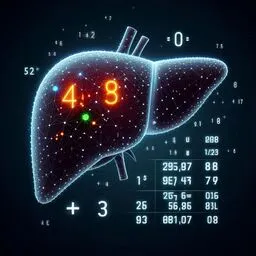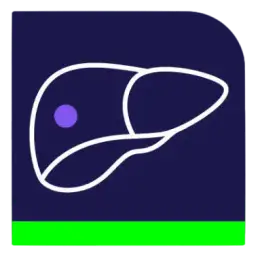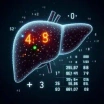Hepatic Fat Calculator and Report Generator for CT & MRI
References:
- Starekova J, Hernando D, Pickhardt PJ, Reeder SB. Quantification of Liver Fat Content with CT and MRI: State of the Art. Radiology. 2021 Nov;301(2):250-262. doi: 10.1148/radiol.2021204288. Epub 2021 Sep 21. PMID: 34546125; PMCID: PMC8574059.
- Qayyum A, Nystrom M, Noworolski SM, Chu P, Mohanty A, Merriman R. MRI steatosis grading: development and initial validation of a color mapping system. AJR Am J Roentgenol. 2012;198(3):582-588. doi:10.2214/AJR.11.6729
- Guo Z, Blake GM, Li K, et al. Liver Fat Content Measurement with Quantitative CT Validated against MRI Proton Density Fat Fraction: A Prospective Study of 400 Healthy Volunteers [published correction appears in Radiology. 2024 Mar;310(3):e249010. doi: 10.1148/radiol.249010]. Radiology. 2020;294(1):89-97. doi:10.1148/radiol.2019190467
- Vu KN, Gilbert G, Chalut M, Chagnon M, Chartrand G, Tang A. MRI-determined liver proton density fat fraction, with MRS validation: Comparison of regions of interest sampling methods in patients with type 2 diabetes. J Magn Reson Imaging. 2016;43(5):1090-1099. doi:10.1002/jmri.25083
Related Calculators:

More about the Hepatic Fat Calculator
The hepatic fat calculator, also referred to as a liver fat calculator or liver steatosis calculator, is designed to estimate the amount of fat in the liver, known as liver fat fraction or hepatic fat fraction. Fat accumulation in the liver, medically termed hepatic steatosis, is increasingly common due to rising rates of obesity, diabetes, and metabolic syndrome. While mild fat accumulation may not produce symptoms, it can progress to more significant liver conditions if unmonitored. Using this liver fat calculator, clinicians and researchers can quickly calculate hepatic fat fraction from imaging studies, providing insight into liver health and supporting patient management decisions.
Importance of Liver Steatosis Assessment
Quantifying hepatic fat fraction is essential for understanding a patient’s liver health. Higher liver fat fraction is associated with an increased risk of progression to non-alcoholic fatty liver disease (NAFLD), non-alcoholic steatohepatitis (NASH), fibrosis, and cirrhosis. Assessing liver steatosis can guide lifestyle recommendations, therapeutic interventions, and monitoring strategies. Additionally, liver fat fraction is linked to cardiovascular risk, insulin resistance, and overall metabolic health, making the use of a liver steatosis calculator valuable in both clinical and research settings.
Imaging Modalities for Liver Fat Quantification
The hepatic fat calculator supports multiple imaging modalities to estimate liver fat fraction:
- MRI: MRI, particularly with proton density fat fraction (PDFF) techniques, provides a quantitative measurement of hepatic fat. The hepatic fat calculator uses PDFF values to give a reproducible estimate of liver fat fraction that correlates with histology.
- Non-Contrast CT: Using liver attenuation values in Hounsfield Units (HU), the liver steatosis calculator estimates fat accumulation. Lower HU values or liver-to-spleen ratios can indicate higher hepatic fat fraction, providing a simple, non-invasive measure of steatosis.
- Contrast-Enhanced CT: Contrast phases can affect attenuation readings. This liver fat calculator adjusts measurements to provide a semi-quantitative assessment of hepatic fat fraction from enhanced CT scans when available.
Clinical Applications of the Liver Fat Calculator
The liver fat calculator can support multiple areas of clinical practice:
- NAFLD and NASH Evaluation: Helps differentiate simple steatosis from more advanced liver conditions, assisting in monitoring disease progression.
- Risk Assessment: Higher liver fat fraction can indicate elevated risk for liver-related complications and metabolic syndrome.
- Therapeutic Monitoring: Tracks changes in hepatic fat fraction during interventions like diet, exercise, medications, or surgical treatments.
- Preoperative Planning: Estimating liver fat fraction can inform surgical decisions for liver resection or transplantation.
- Research: Standardized liver fat fraction measurements support clinical trials and studies on liver disease and treatment outcomes.
Enhancing Workflow Efficiency
Manual evaluation of liver fat on imaging can be time-consuming and variable. The hepatic fat calculator streamlines this process by quickly providing liver fat fraction estimates based on imaging data, allowing clinicians to focus on interpretation and patient care. It can be used alongside PACS systems or integrated into radiology workflows, supporting both efficiency and consistency.
Features of the Liver Steatosis Calculator
- Multi-Modality Input: Accepts MRI, non-contrast CT, and contrast-enhanced CT measurements.
- Quantitative Assessment: Provides numeric estimates of hepatic fat fraction or liver fat fraction for clear tracking over time.
- Accessible Interface: Simple inputs and automated calculations make the liver fat calculator easy to use in routine clinical practice.
- Educational Tool: Offers insight into liver imaging interpretation for trainees and clinicians new to hepatic steatosis evaluation.
Using Hepatic Fat Fraction in Patient Care
Understanding liver fat fraction through this liver steatosis calculator helps clinicians monitor liver health, counsel patients on lifestyle changes, and evaluate responses to therapy. It supports data-driven decisions and can be part of comprehensive liver assessments alongside elastography or laboratory studies.
Looking Ahead
As liver disease prevalence rises, tools like the hepatic fat calculator will become increasingly important in clinical practice. Future developments may include integration with advanced imaging techniques and automated data extraction, further enhancing assessment of hepatic fat fraction and steatosis severity.
Summary
The hepatic fat calculator provides an accessible, imaging-based approach to estimating liver fat fraction and liver steatosis. By supporting MRI and CT-based assessments, it offers clinicians and researchers a consistent and practical method to monitor hepatic fat fraction and support informed decision-making in patient care and research.
Frequently Asked Questions (FAQ)
- What does the hepatic fat calculator measure?
It estimates the percentage of fat in the liver, known as the hepatic fat fraction, using imaging data from MRI or CT scans. This helps identify and monitor liver steatosis (fat accumulation in the liver). - Why is measuring liver fat important?
Excess liver fat is linked to non-alcoholic fatty liver disease (NAFLD), non-alcoholic steatohepatitis (NASH), fibrosis, and cirrhosis. Tracking hepatic fat fraction helps clinicians detect early liver changes and prevent disease progression. - Which imaging methods can be used with this calculator?
The calculator supports MRI, non-contrast CT, and contrast-enhanced CT. MRI with proton density fat fraction (PDFF) provides the most accurate measurement, while CT-based methods use attenuation values or liver-to-spleen ratios to estimate fat content. - Can I use CT scans with contrast for this calculation?
Yes. Although contrast affects attenuation readings, the calculator adjusts for this to provide a semi-quantitative estimate of liver fat when only contrast-enhanced scans are available. - What is considered a normal liver fat fraction?
A hepatic fat fraction below 5% is typically considered normal. Values above that suggest steatosis, with higher levels indicating increasing severity. - How does this calculator help in managing patients with NAFLD or NASH?
It allows clinicians to quantify and track liver fat over time, assess response to treatment, and identify patients at risk for progression to NASH or fibrosis. - Can the calculator replace a liver biopsy?
In many cases, yes. MRI-based hepatic fat quantification closely correlates with histologic fat content, reducing the need for invasive biopsy in patients being monitored for steatosis. - Is the hepatic fat calculator useful for research?
Absolutely. Standardized and reproducible liver fat fraction measurements are valuable for clinical trials studying metabolic disease, drug efficacy, and long-term liver outcomes. - What factors can affect accuracy?
In CT-based assessments, factors such as contrast phase, scanner calibration, and ROI placement can influence results. MRI PDFF remains the most reliable method when available. - How often should liver fat be measured?
Frequency depends on clinical context. In patients with metabolic syndrome or known NAFLD, repeating imaging after lifestyle or therapeutic interventions helps assess improvement or progression. - Can this calculator be used in surgical or transplant planning?
Possibly. Estimating hepatic fat fraction is valuable for assessing donor liver suitability and predicting surgical outcomes in hepatic resection or transplantation. - Does the calculator provide absolute diagnostic thresholds?
No. It offers quantitative support, but interpretation should always be combined with clinical, laboratory, and other imaging findings for a complete picture of liver health.





